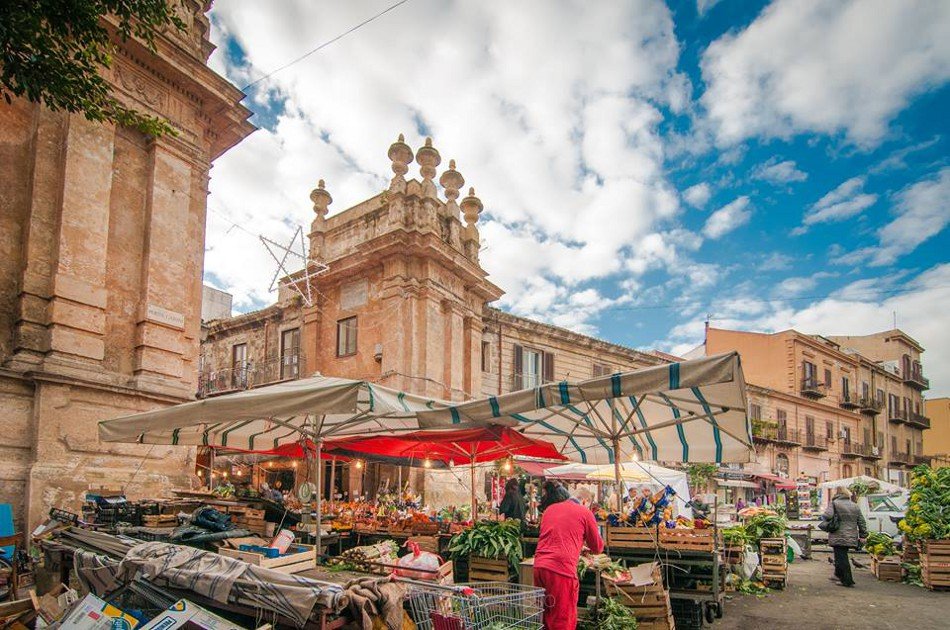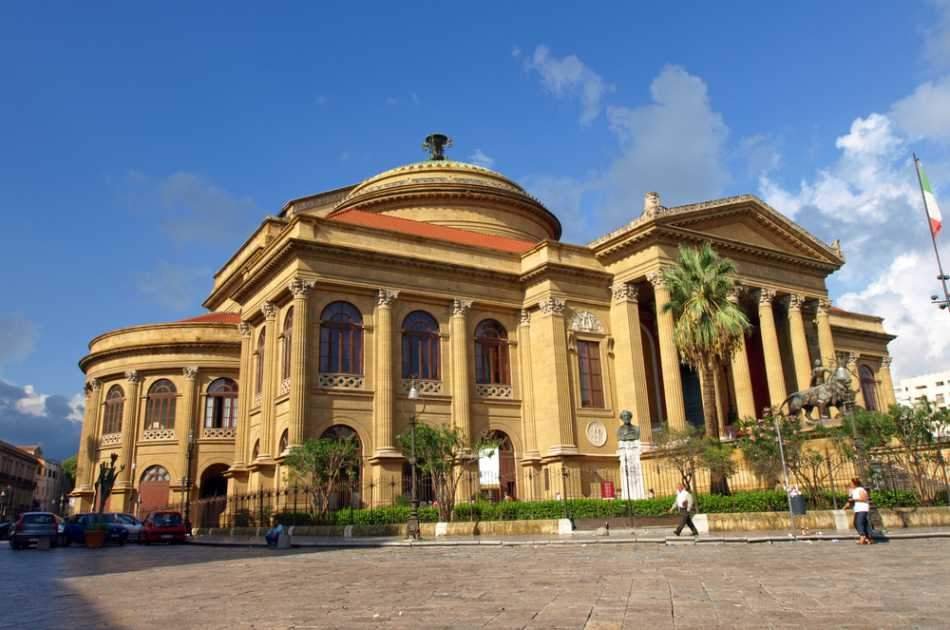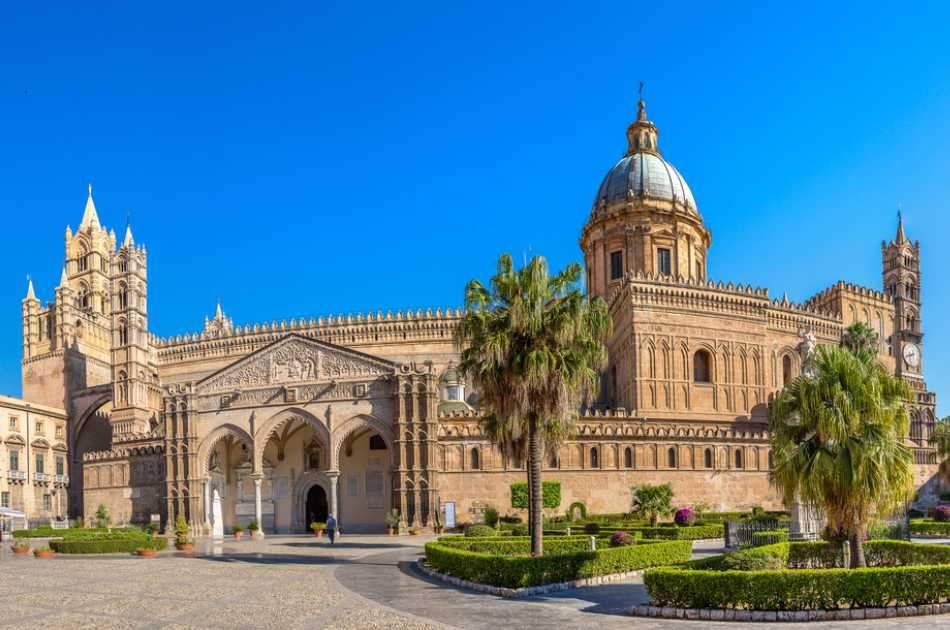Discover Monuments and Markets in Palermo
During this 3-hour walking tour, you will see the Massimo Vittorio Emanuele Theatre, the third largest opera house in Europe. It was built in 1875 and has more than 1,300 seats. Admire the beautiful Arab-Norman Palermo Cathedral and Palazzo Reale (King or Norman Palace), which became part of UNESCO's list of World Heritage Sites.
See also the Church of Casa Professa (or Church of Gesù), the most important Baroque church in Palermo, as well as the Eagles Palace, an outstanding palace of the 15th century. There, you can enter the red room of the mayor and the city council. Continue to Pretoria Square, also known by locals as 'Square of Shame' for the nudity of the statues.
Visit Bellini Square on which you'll see the Church of San Cataldo and Martorana Church. During the tour, you will also see the famous old markets of Palermo - Ballarò, Capo, and Vucciria, where, if you want, you can buy and taste some of the city's famous street food: panelle, crocchè, and arancine.
The tour ends in the exact centre of historic Palermo, the Quattro Canti square. It was built between 1608 and 1620 at the crossing of the two most important streets in Palermo, Corso Vittorio Emanuele and Via Maqueda.
- Visit food markets and have the option to purchase classic snacks
- Hear about the sites listed by UNESCO in Arab-Norman Palermo
- Be amazed by the colorful and intricate decor inside the Chiesa del Gesù
- Admire the architecture of Teatro Massimo and the Palermo Cathedral
- 3-hour walking tour in Palermo’s historic center, from Verdi Square
 Scheduling: Shared Tour
Scheduling: Shared Tour
 Languages offered on the Activity / Tour: English
Languages offered on the Activity / Tour: English
 Duration: 3 hours
Duration: 3 hours
 Printed or Mobile Voucher Accepted
Printed or Mobile Voucher Accepted A minimum of 3 people is required to book this tour
A minimum of 3 people is required to book this tour  Pick-up serviceWe organize the pick-up only for the cruise passengers just outside the port.
Pick-up serviceWe organize the pick-up only for the cruise passengers just outside the port. Ship to shore “Stress-free” tour guarantee. Get a full refund for non-docking ships or late port arrivals.
Ship to shore “Stress-free” tour guarantee. Get a full refund for non-docking ships or late port arrivals. Easy CancellationThere is no cancellation fee once Customers Cancel at least 7 day(s) prior to the date of the activity or tour.
Easy CancellationThere is no cancellation fee once Customers Cancel at least 7 day(s) prior to the date of the activity or tour.
There is 50% cancellation fee for Customers to Cancel 3 and 6 day(s) prior to the date of the activity or tour.
There is 100% cancellation fee for Customers to Cancel 2 day(s) prior to the date of the activity or tour.
 Confirmation will be received within 24 hours of booking, subject to availability
Confirmation will be received within 24 hours of booking, subject to availability
- Pick-up for the cruise passengers
- Local and professional guide
- Entrance / admission in the Cathedral
- Food, drinks and souvenirs
- Entrance tickets
Interesting square with the Salinas Archeological Museum and a lot of restaurants, meeting point for the night life 0f the citizen of Palermo.
The Massimo Vittorio Emanuele Theatre is the third largest opera house in Europe. It was built in 1875 and has more than 1,300 seats. We talk about its history and legeds.
One of the best ways to get to know a city is through its food and markets. Mercato di Capo is one of the best markets in Palermo. The stalls in this market sell a wide variety of food including local specialties, fruits and vegetables, meat and fish. When you walk through the market, you will hear vendors yelling or chanting in their Palermo dialect
The Cathedral, the beautiful Arab-Norman Palermo Cathedral, which became part of UNESCO's list of World Heritage Sites in the 2015. You will see it also inside. Erected in 1185 by Walter Ophamilio, the Anglo-Norman archbishop of Palermo. As an architectural complex, it is characterized by the presence of different styles, due to a long history of additions, alterations and restorations, the last of which occurred in the 18th century.
The Palazzo dei Normanni (Palace of the Normans) or Royal Palace of Palermo was the seat of the Kings of Sicily during the Norman domination. Today it is the seat of the Sicilian Regional Assembly. The building is the oldest royal residence in Europe.
The Cassaro is the most ancient street of Palermo. Following the unification of Italy, it has been officially renamed Via Vittorio Emanuele II, but the old and distinctive name is still in use. The street is rooted in the age of the foundation of Palermo by the Phoenicians.
If you are looking to immerse yourself in the local culture of Palermo, the Ballarò Street Market is the place to go. As the city’s oldest street market and one of the most vibrant markets in Europe, Ballarò also provides a glimpse into Palermo’s past where you can listen for street vendors speaking a local dialect similar to Arabic. Said to be more than 1,000 years old. The name Ballarò comes from Bahlara, a town outside Palermo where Arab merchants historically made their home
The Church of the Gesù is one of the most important Baroque churches in Sicily. Built by the Jesuits in the late 16th century on the edge of Palermo’s Jewish Quarter, the church took almost 50 years to build, with help from hundreds of artists and artisans. Inside, visitors will find colorful frescoes, intricate stone carvings and marble reliefs in a stunning setting for reflection and worship.
The church known most commonly as “La Martorana” is an architectural example of Sicily’s changing allegiances over the centuries. The facade alone features three different architectural styles. The Martorana (Santa Maria dell’Ammiraglio is the official name) dates back to 1141. You can no longer see the original Norman facade, but you can still see the typical Norman red dome from the exterior. Thankfully, once you’re inside the church, the original 12th century mosaics still shine in all their Byzantine glory.
It is the Palermo’s most famous square. The centerpiece of the Piazza Pretoria is the fountain, known as the Fontana Pretoria. Designed in the 1550s by a sculptor from Florence named Camilliani, the fountain was originally commissioned for a private villa in Tuscany, but was gifted to the city of Palermo in 1574. There are 16 figures on the Fontana Pretoria, all of which are entirely or partially nude, that circle the fountain. There is no side from which you can simply enjoy the water itself without seeing a nude statue - which many Palermitans in the late 16th century found scandalous. This is the reason for which the citizens call it "The fountain of the shame".
Despite the fact that the Quattro Canti - also known as the Piazza Vigilena - is an intersection that’s often full of cars, it’s still one of the attractions visitors seek out in the city. This is largely because of the four buildings that sit at the four corners of the intersection - “quattro canti” means “four corners” - which are Baroque buildings dating from the early 17th century. The four buildings are almost identical, save for a few details. Each of the four buildings is slightly curved, giving the piazza a rounded footprint, and there are statues in niches that represent the four seasons, the four Spanish kings of Sicily, and the four patron saints of Palermo. Each building is connected to a different Palermo neighborhood, and the patron saint on that building is the patron of that neighborhood.
- Dress code is smart casual
- Children must be accompanied by an adult
- Excellent 5
- Very Good 4
- Average 3
- Poor 2
- Terrible 1
-
(490)
-
(248)
-
(0)
-
(0)
-
(0)
4.5
- Comments (0)
- Photos (0)






 Product code: 4485
Product code: 4485  © Copyright 2024 Private Tour Inc. All Rights Reserved.
© Copyright 2024 Private Tour Inc. All Rights Reserved.